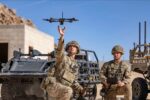As large language models (LLMs) gain traction across sectors, the defense domain faces unique challenges in adapting these tools to mission-critical contexts. The MLRIP framework—Military Language Representation with Informative Pretraining—proposes a tailored approach to pretraining language models for military applications by integrating structured factual and doctrinal knowledge. This article explores the architecture behind MLRIP, its use of professional military knowledge bases (PMKB), and its potential impact on natural language processing (NLP) in defense intelligence, command-and-control (C2), and decision support systems.
Why General-Purpose LLMs Fall Short in Defense Contexts
While commercial LLMs like GPT-4 or BERT have demonstrated impressive capabilities in general NLP tasks, their effectiveness drops significantly when applied to domain-specific military texts. This is due to:
- Lack of domain-specific terminology: Military jargon includes acronyms (e.g., C4ISR), weapon system designations (e.g., M142 HIMARS), and doctrinal phrases not found in common corpora.
- Contextual ambiguity: Words like “fire,” “target,” or “engage” carry drastically different meanings in tactical vs civilian contexts.
- Security constraints: Training on open-source data excludes classified or sensitive operational knowledge critical for accurate modeling.
To bridge this gap, MLRIP proposes a two-stage pretraining pipeline that injects both factual knowledge from structured sources and professional expertise from curated military documents into the model’s representation space.
The MLRIP Framework: Architecture and Methodology
The core innovation of MLRIP lies in its dual-source pretraining strategy. The model is first exposed to a factual knowledge graph derived from open-source encyclopedic content (e.g., Wikipedia), followed by fine-tuning on a Professional Military Knowledge Base (PMKB). This two-step process ensures both general world understanding and deep domain specialization.
Stage 1: Factual Knowledge Injection
This phase uses a structured knowledge graph constructed from Wikipedia entries relevant to geopolitics, weapon systems, historical conflicts, organizations (e.g., NATO), and treaties. Entities are linked via semantic relationships such as “is part of,” “developed by,” or “used during.” The graph is then transformed into text triplets for training using masked language modeling (MLM) objectives.
Stage 2: Professional Knowledge Fine-Tuning
The second stage introduces curated documents from PMKB sources including:
- Tactical field manuals
- Doctrinal publications (e.g., JP 3-0 Joint Operations)
- Defense acquisition reports
- Weapon system specifications
This corpus is used for task-specific fine-tuning with objectives such as next sentence prediction (NSP) and contextual embedding alignment. The result is a model capable of understanding nuanced relationships between operational terms and real-world entities.
Datasets and Evaluation Benchmarks
The authors constructed two custom datasets for evaluation:
- MILVAQ: A multiple-choice question dataset testing factual recall across categories like equipment types, historical battles, alliances, etc.
- MILNLI: A natural language inference dataset assessing logical reasoning over doctrinal statements (“If X occurs under Y conditions…”).
The MLRIP model outperformed baseline BERT-based models pretrained on general corpora by up to 18% on MILVAQ accuracy scores and showed superior consistency on entailment tasks within MILNLI. Notably, it also demonstrated better robustness against adversarial phrasing—a crucial feature for information extraction in noisy battlefield communications or intercepted signals intelligence (SIGINT).
Tactical Implications for Defense NLP Applications
A well-trained military-specific LLM opens new opportunities across several mission areas:
- C2 Systems Integration: Natural-language interfaces for querying battlefield status (“What artillery assets are within range?”)
- SIGINT/OSINT Fusion: Automated summarization of intercepted messages with context-aware threat tagging
- TTP Analysis: Extraction of tactics from after-action reports or debriefings using semantic clustering
- MRO Documentation Parsing: Automatic classification of maintenance logs by platform/component/failure type
This aligns with broader NATO efforts under programs like Federated Mission Networking (FMN) where semantic interoperability between allies remains a challenge. Embedding doctrinal consistency into machine-readable formats could accelerate coalition planning cycles significantly.
Caveats and Future Research Directions
The authors acknowledge several limitations that warrant further research before operational deployment:
- Lack of multilingual support: Current implementation focuses solely on English-language corpora; future versions should incorporate allied doctrine in French/German/Polish/Ukrainian/Russian/etc.
- No handling of classified data tiers: While PMKB is curated from unclassified sources only, real-world use would demand secure enclaves or zero-trust architectures for sensitive inputs.
- No reinforcement learning loop yet implemented: Human-in-the-loop feedback could further refine model alignment with operator intent during live missions.
The team proposes expanding the PMKB via collaboration with defense think tanks or simulation environments like OneSAF to generate synthetic but realistic training data at scale. Another avenue includes integrating geospatial embeddings so that queries can be grounded not just semantically but spatially (“Which units are within X km radius under Y terrain?”).
A Step Toward Mission-Aware Artificial Intelligence
The MLRIP framework represents an important step toward developing mission-aware artificial intelligence tailored to the unique linguistic demands of modern warfare. By combining structured factual graphs with deeply curated doctrinal content during pretraining phases—and validating performance against purpose-built benchmarks—the approach sets a precedent for future defense-oriented NLP architectures.
If adopted at scale within C4ISR ecosystems or ISR fusion centers, such models could reduce analyst burden while improving decision latency—a key factor in high-tempo operations such as air-defense cueing or EW threat detection. However, success will depend not only on algorithmic sophistication but also on secure deployment frameworks that respect classification boundaries while enabling real-time inference at the edge.










